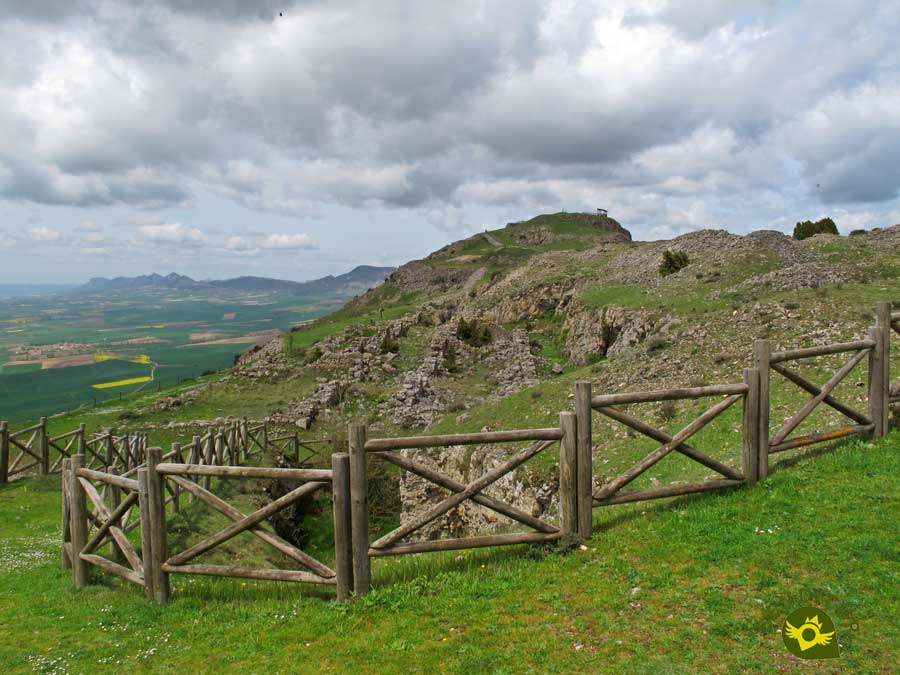Guarding the access to Castilla, the ruins of the Fortress of Santa Engracia are located at the top of the Castillete peak, on one of the rocky walls that surround the Pancorbo gorge. Construction began in 1794 during the Convention War in order to block the passage of French revolutionary troops towards Castilla. The execution of the works was not without its difficulties, the haste with which they were carried out, the orography of the terrain, the inclement weather, the lack of money... Three years later, in 1797, the fortress was operational and finished. During the War of Independence in 1808 it was taken and occupied by Napoleon's troops, who remained there until 1813, when it was recovered by General O'Donnell in the battle known as the "Siege of Pancorbo". A decade later, in 1823, it was again the French troops, "The Hundred Thousand Sons of Saint Louis", who, under the orders of the Duke of Angoulême, destroyed it in order to prevent the liberal troops fighting against the absolutist Ferdinand VII, they became strong here. Thus ended the short but intense wartime history of the Fortress of Santa Engracia, but its strategic location brought it back to life in the mid-19th century when its towers were used as position 32 of the Line of Castile, as part of the optical telegraph system.

The work to recover the architectural remains and the spectacular orography in which the ruins of the Fortress of Santa Engracia are located make it an ideal place to visit, enjoying, at the same time, nature and history in a setting that will not leave us impassive. Santa Engracia was a complex fortification made up of various bastions, the remains of which can be recreated today by following a network of paths and walkways and with the help of the information panels placed in situ. The entire defensive complex had a capacity for 3575 people. The fortress is distributed around a Parade Ground protected by a series of bastions: the Navas Front to the north, San Nicolás to the east, San Bernardo and San Sebastián to the south and San Carlos to the west. All of them were formed by different bastions and batteries. The San Bernardo front mainly housed the soldiers. The fortified complex also had all kinds of auxiliary facilities essential for daily life, cisterns and numerous caves that housed a bakery, kitchen, blacksmith's, hospital, food and ammunition stores, etc. As a culmination and complement to this entertaining visit, we can rest and entertain ourselves by watching the Losinos horses, native to the area and bred in semi-freedom. We can also follow the hiking route, Path of Pancorbo PRC BU89, which takes us from Pancorbo to this incredible Fortress of Santa Engracia.

In the 18th century, troops were recruited by voluntary enlistment, by fifths, taking one man out of every five, or by levies (recruitment of people for service, generally soldiers, which was done especially of criminals and vagabonds to nourish the ranks of the army in war). The conditions required were to be between 16 and 40 years old, to be catholic-apostolic-roman, at least 1.40m tall, and not to be what was then called " infamous extracion ", a mulatto, a gypsy, an executioner or a butcher.

Come invasions that will crash; fear not Castilla, they will not pass; nor from Andalucía the fierce Moor, nor from the Pyrenees the great Napoleon; watch in Santa Engracia of Spain the lion (from the hymn to Pancorbo, lyrics by Don Teodoro de Izarra, 1940).
MORE ROUTES AVAILABLE, DON'T MISS IT...
MORE PLACES AVAILABLE, DON'T MISS IT...
The town of Pancorbo is located in the middle of the N-1 road, colloquially known as the road to Irún, in the section between Miranda de Ebro and Briviesca. The N-232 Logroño-Santander road and the AP-1 motorway also pass through Pancorbo. Once there, head in the direction of Miranda, crossing Pancorbo through its interior, until you reach the beginning of the signposted path that climbs up to the car park at the foot of the fortress.
There is a bus service from Monday to Friday, working days, with different timetables linking Pancorbo with Miranda de Ebro and Burgos. The information telephone number for this service is 947 472 830.
Pancorbo has a train station with stops on the Madrid-Irún line. It also has a regional and medium-distance train service, which from Monday to Saturday, at different times, connects it with Miranda de Ebro, Briviesca and Burgos. For further information, the R.E.N.F.E. telephone number is 912 320 320.
SENDITUR is not responsible for any variation in the information described or for the misuse of its guides and recommends that everyone be responsible and prudent in carrying out the activity. Likewise, we invite you to read books and specialised guides to complement the information described. From SENDITUR's commitment to Nature and respect for the balance of the environment, SENDITUR urges you to travel in a responsible way, with low environmental impact and respecting at all times the Natural, Cultural and Social environment wherever you go. For any suggestions, SENDITUR invites you to send an email to
Continue watching …